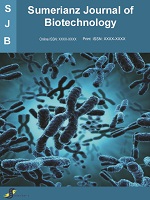Sumerianz Journal of Biotechnology

Online ISSN: 2617-3050
Print ISSN: 2617-3123
Quarterly Published (4 Issues Per Year)
Journal Website: https://www.sumerianz.com/?ic=journal-home&journal=32Archive
Volume 2 Issue 7 (2019)
Phytochemical Profiling and Biological Activity of Tamarix Nilotica Leaves Extract
Authors : Mozzamil A. Ahmed ; Assad K. Mohammed ; Salih O. Mohammed ; Salma A. Salih ; Abdelhalim A. Hamza
Abstract:Tamarix nilotica. (Tamaricaceae) is one of the most used plants in Sudan folkloric medicine. The powdered leaves of Tamarix nilotica were extracted using 80% methanol; the methanolic extract was then fractionated by Petroleum ether, Chloroform and Ethyl acetate. Phytochmical profiling was carried for all fractions of Tamarix nilotica leaves by using Thin Layer Chromatography (TLC). The TLC chromatogram revealed the presence of Flavonoids, Phenolic acids, Coumarins, Terpenoids and Alkaloids. However, the ethyl acetate fraction was the richest fraction with polyphenols. The radical scavenging activity of Tamarix nilotica leaves was screened by using 1, 1-diphenyl-2-picrylhydrazyl (DPPH), the antioxidant results were expressed as concentration of inhibition (IC50) of the free radical DPPH. The extract give highest antioxidant activity 82±0.01% with IC50 0.0093∓0.09μg/ml. compared to the control standard Gallic acid. The scavenging activity of Tamarix nilotica leaves fractions increases correspondingly with the increasing polyphenolic content. The aforementioned extract was screened for antimicrobial activities against five standard bacteria (Bacillus subtitles, Staphylococcus aureus, Pseudomonas aeruginosa, and Escherichia coli, one fungi (Candida albicans) using in vitro agar well diffusion method. The methanolic extract at a concentrations (5mg/ml) was significantly active against Staphylococcus aureus (20 mm), Bacillus subtilus (18 mm), Protues vulgaris (20 mm), Pseudomona. aeruginosa,(21 mm) and Escherichia coli (14 mm). Furthermore, this extract at the same concentration possessed activity against Candida albicans (20 mm). Methanolic extracts of Tamarix nilotica showed stronger action against urease activity, parentage of inhibition (loss of enzyme activity) reported as ˃ 70%.
Microbiological Quality Assessment of Ready-To-Eat Fried Chicken and Chicken Soup Samples Sold in Dhaka Metropolis, Bangladesh
Authors : Moushumi Akter ; Selina Sultana ; Saurab Kishore Munshi
Abstract:Contamination of ready-to-eat foods with pathogenic microorganisms depicting them unacceptable for human consumption and has become a global health problem. Current study attempted to investigate the occurrence of bacterial contamination in ready-to-eat fried chicken and chicken soup samples. In this regard, a total of fifteen fried chicken samples and twelve chicken soup samples were collected from Chinese restaurants, fast food shops and street food shops along with homemade samples. Microbiological analysis of fried chicken revealed that homemade samples and samples from Chinese restaurants and fast food shops were safe for consumption as microbial load was found to be within the acceptable limit. While, the load of total viable bacteria and fungi exceeded the standard microbial limit in the samples collected from University canteen and street food shops. E. coli and Klebsiella spp. along with Staphylococcus spp. and Pseudomonas spp. were also encountered in those samples. In case of chicken soup, homemade samples were found to be good for consumption as only total viable bacteria was found which was in acceptable range. On the other hand, chicken soup samples from street food shops were found to be unacceptable for consumption. Along with total viable bacteria and fungi, specific bacteria including Klebsiella spp., E. coli, Pseudomonas aeruginosa, Pseudomonas putida and Staphylococcus spp. above the acceptable limit were encountered in that samples. In addition, all the isolates from both the types of samples were found to be multidrug resistant. In case of fried chicken samples, the isolates showed resistance against Cefuroxime and Novobicin. Whereas, Azithromycin, Cefiprime, Ceftriaxone, Ciprofloxacin, Meropenem and Amikacin sensitivity were found in all the isolates. For chicken soup samples, all the pathogenic bacterial isolates were found to be resistant against Cefuroxime, Vancomycin, Amoxycilin and Novobicin. On the other hand, the isolates were found to be sensitive against Azithromycin, Kanamycin, Ceftriaxone, Ciprofloxacin, Meropenem and Amikacin. Presence of microbial contaminants in some tested samples and the occurrence of drug resistance in the bacterial isolates portray the public health risk in the consumption of such food.
Dynamics of 18 (Sophora Japonica) Tree Individual Trunk Volume along Elevation Gradient in Ye County
Authors : Bing-Hua Liao ; Ying-Ping Liu ; Hai Zuo ; Ying-Ying Kong ; Cai-ge Jiang ; Jun-rong Xia ; Chang-jian Song ; Xiao-guang Zhang ; Zu-yun Yu ; Ya-long Xu
Abstract:Applying communities diversity techniques and SPSS statistic analysis, this study quantify how that correlation between 18 (Sophora japonica) individual trunk volume and elevation along elevation. We concluded that there is a significantly positive correlation between 18 (Sophora japonica) individual trunk volume and elevation (P<0.01). Elevation is a key factor driver (Sophora japonica) individual trunk volume increased along elevation from 50m to 200m. Therefore, understanding dynamic connection between 18 (Sophora japonica) individual trunk volume and elevation can be not just applied to preserve of 18 (Sophora japonica) individual trunk volume, but also applied to sustainable of tree diversity and ecological processes of trunk volume of different tree individual specie along elevation at spiral-temporal-environmental scales in the future of Ye County in 2018.


